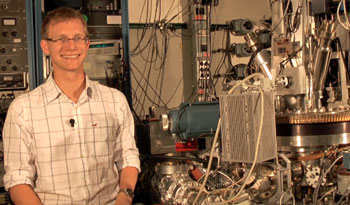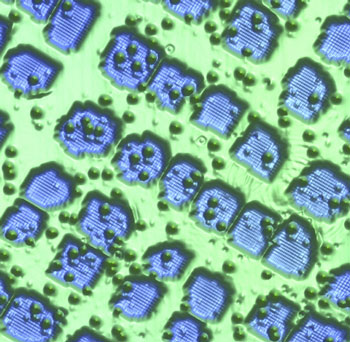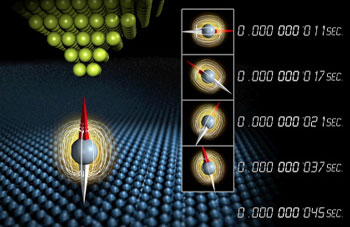| Posted: Sep 28, 2010 | |
Nanotechnology gains the ability to measure nanosecond-fast phenomena |
|
| (Nanowerk Spotlight) As technology keeps getting faster and smaller, the computer industry is working towards the end of the Moore's Law roadmap where technology will eventually be designed and created at the atomic level. Rather than working their way down incrementally, some researchers are taking a different approach by exploring what happens at the end of Moore's Law, specifically whether it is possible to do computing and other work at that scale. This means they are asking questions like, 'how many atoms are needed to store information', and 'are there schemes to do computation with magnetic atoms instead of transistors'? | |
| An IBM research team at the company's Almaden Research Center has now demonstrated, for the first time, the ability to measure how long an individual iron atom can hold magnetic information. They show how a scanning tunneling microscope can measure electron spin relaxation times of individual atoms adsorbed on a surface with nanosecond time resolution using an all-electronic pump-probe measurement scheme. | |
| "We developed a new, all-electronic pump-probe technique that can detect how the orientation of an iron atom's magnetic moment evolves in time by using the scanning tunneling microscope as a high-speed video camera capable of up to 100 million frames per second," Sebastian Loth, an Almaden post-doctoral researcher, tells Nanowerk. | |
 |
|
| Sebastian Loth, next to a scanning tunneling microscope. (Image: IBM Research Almaden Lab) | |
| "When objects shrink down to the nanoscale, physical effects tend to speed up" explains Loth. "To explore the fast processes in individual nanostructures, scientists need a tool that can keep up in speed. The new pump-probe technique that we demonstrated is not limited to magnetic dynamics; it provides scientists with the means to study nanosecond dynamics in many different types of nanostructures." | |
| This new technique could potentially be generalized to other systems and opens up huge research opportunities for scientists looking to apply this in fields like storage-class memory, photovoltaics (the conversion of light to energy in organic solar cells and how this energy travels in the solar cell could now be studied at the molecular level), and quantum computing (magnetic atoms are potential candidates for quantum bits, or short qubits, that are no longer limited to the binary bit logic of 1s and 0s). | |
| The research report, first-authored by Loth, appears in the September 24, 2010, online issue of Science "Measurement of Fast Electron Spin Relaxation Times with Atomic Resolution". | |
| The ability to measure nanosecond-fast phenomena opens a new realm of experiments for scientists, since they can now add the dimension of time to experiments in which extremely fast changes occur. To put this into perspective, the difference between one nanosecond and one second is about the same comparison as one second to 30 years. An immense amount of physics happens during that time that scientists previously could not see. | |
| "In the quest to determine whether individual atoms can store information, we were constantly running into the issue that the scanning tunneling microscope would sometimes take minutes to show a picture of an individual atom" says Andreas Heinrich, who leads the scanning probe microscopy project at IBM Research's Almaden lab. "By this time, all the physics has already happened, leaving us with lots of questions. Our new technique combines both space and time into one picture – capturing this incredibly fast activity and recording how long information can actually be stored on the atom." | |
 |
|
| Scanning tunneling microscope topograph of nitride patches (blue) on a copper substrate (green) that serve as nano-workbenches for the assembly of atomic-scale prototype structures from magnetic atoms (green bumps). (Image: IBM Research Almaden Lab) | |
| The IBM researchers had previously determined that an iron atom could hold data for a nanosecond but with the new scanning tunneling microscope technique, they found that when putting a non-magnetic copper atom next to the iron atom, that iron atom could retain data for up to 200 nanoseconds. | |
| Being able to see that change means that scientists can now experiment to see how they can impact the behavior of atoms to get desired results. | |
| This type of fundamental nanotechnology research is critical to moving innovation forward, going all the way back to the days when IBM won the Nobel Prize in 1986 for inventing the scanning tunneling microscope. Since that time, scanning probe techniques have advanced to become a standard research tool where scientists can use these techniques to visualize nano-sized objects on a daily basis. | |
| "Now we added a new measurement method to this toolkit to capture ultra-fast phenomena on individual nano-objects" says Heinrich. "The new tool completes our toolkit to tackle these questions. We can image individual atoms; assemble them in structures of our own design; and now we can measure how the structure affects the time-dependent behavior." | |
| How it Works | |
| Since the magnetic spin of an atom changes too fast to measure directly using previously available Scanning Tunneling Microscope techniques, time-dependent behavior is recorded stroboscopically, in a manner similar to the techniques first used in creating motion pictures, or like in time lapse photography today. | |
| Using a 'pump-probe' measurement technique, a fast voltage pulse (the pump pulse) excites the atom and a subsequent weaker voltage pulse (the probe pulse) then measures the orientation of the atom's magnetism at a certain time after excitation. | |
 |
|
| The pump-probe technique excites magnetic atom by hitting them with electrons and then taking snapshots of their dynamic behavior in nanosecond intervals. (Image: IBM Research Almaden Lab) | |
| In essence, the time delay between the pump and the probe sets the frame time of each measurement. This delay is then varied step-by-step and the average magnetic motion is recorded in small time increments. For each time increment, the scientists repeat the alternating voltage pulses about 100,000 times, which takes less than one second. | |
| In the experiment, iron atoms were deposited onto an insulating layer only one atom thick and supported on a copper crystal. This surface was selected to allow the atoms to be probed electrically while retaining their magnetism. The iron atoms were then positioned with atomic precision next to non-magnetic copper atoms in order to control the interaction of the iron with the local environment of nearby atoms. | |
| The resulting structures were then measured in the presence of different magnetic fields to reveal that the speed at which they change their magnetic orientation depends sensitively on the magnetic field. This showed that the atoms relax by means of quantum mechanical tunneling of the atom's magnetic moment, an intriguing process by which the atom's magnetism can reverse its direction without passing through intermediate orientations. This knowledge may allow scientists to engineer the magnetic lifetime of the atoms to make them longer (to retain their magnetic state) or shorter (to switch to a new magnetic state) as needed to create future spintronic devices. | |
| "Over the past years we have witnessed dramatic advances in the field of nanoscience" says Loth. "In the past, we have been merely spectators that could only see static pictures of the nanoworld. Future research will become increasingly interactive: being able to see the nanosecond fast evolution of individual magnetic atoms is just the first step. We will develop new skills to see other effects, even faster phenomena and learn to harness properties of matter on the atomic level." | |
| He concludes: "All this is exploratory research and it is important to us at IBM to keep it that way: exploratory. In the future we will not be able to live of incremental advances of current technology. Pressing questions like energy conservation and environment protection require new thinking and advances in nanotechnology will help to find the answers." | |
| Watch a video where Loth and Heinrich explain the new technique: | |
 By
Michael
Berger
– Michael is author of three books by the Royal Society of Chemistry:
Nano-Society: Pushing the Boundaries of Technology,
Nanotechnology: The Future is Tiny, and
Nanoengineering: The Skills and Tools Making Technology Invisible
Copyright ©
Nanowerk LLC
By
Michael
Berger
– Michael is author of three books by the Royal Society of Chemistry:
Nano-Society: Pushing the Boundaries of Technology,
Nanotechnology: The Future is Tiny, and
Nanoengineering: The Skills and Tools Making Technology Invisible
Copyright ©
Nanowerk LLC
|
|
|
Become a Spotlight guest author! Join our large and growing group of guest contributors. Have you just published a scientific paper or have other exciting developments to share with the nanotechnology community? Here is how to publish on nanowerk.com. |
|
